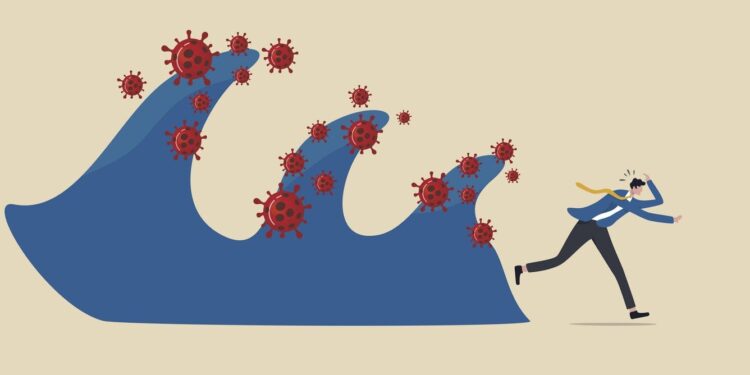As countries around the world consider when and how to ease restrictions, attention is being focused on the best ways to avoid second or even third waves of Covid-19 infections as a third wave is happening in some countries.
It is not the suffusion of a Mexican wave, which is normally greeted with some excitement.
It is a wave of COVID-19 pandemic currently underway in some countries. According to the World Health Organisation (WHO), Europe’s case numbers of COVID-19 grew by a million in the short span of 10 days, inching up the total number of reported cases to seven million.
At the beginning of the Covid-19 pandemic, many countries enforced lockdowns and social distancing measures to halt the spread of the coronavirus. As case numbers waned and the lockdowns lifted, many people believed that the worst had passed and began meeting others socially again. Unfortunately, these attempts to enjoy what remained of the summer had negative consequences.
All over the world, even in countries that seemed to be handling the cases well, the number of active Covid-19 infections is rising. Ghana, yes I mean Ghana because the West African country has also been acclaimed as one of the countries with effective handling the COVID-19 pandemic.
So impressed has been the fight against the virus that one website ranked Ghana as the third most successful country to tackle the pandemic head-on.
But that was what Hong Kong used to be, the darling boy in the fight against COVID-19, but now experiencing its third wave.
This is exactly why the Ghana Medical Association (GMA) has an uneasy feeling. Of course, Ghana has so far handled the pandemic in a way that tickles the fancy of certain countries, including some affluent ones.
However, a cursory look at people in our markets, funerals, trotros and even in our hospitals show that people feel the worst is over with this pandemic.
Canada, which was down to low double digits in its daily new infections at one point, is now back to about 3,000 new infections per day. Even the EU, which had a strong first response to the pandemic, has seen the number of cases rise to the low hundreds of thousands since the beginning of October.
This new wave is partially due to policy softening under pressure from the economy. The retail, restaurant, and service sectors were heavily impacted by the lockdowns. As such, governments had to pay large amounts of money to keep their countries’ economy afloat. Because of this, governments were strongly incentivised to ease the lockdowns to restart the economy. However, this new wave of Covid-19 cases will end up costing more in the long term.
The new wave of cases is also due to people not fully respecting the virulence of the virus and ignoring the necessity of social distancing. There have been multiple instances of people making news for holding large in-person gatherings that are either not recommended or outright illegal.
Spain, on Sunday, October 25, reimposed curfew in a bid to curtail a massive surge in COVID-19 cases.
America is touted to be experiencing its third wave, starting when President Trump got diagnosed with the disease in early October.
Cases have increased in astronomical proportions, particularly in some states in North Dakota, where the wearing of masks is not compulsory.
Iran, described as the crucible of coronavirus in the Middle East, is experiencing its third and most deadly wave of the coronavirus pandemic since the outbreak started in March.
According to the BBC, Hong Kong is also experiencing its third wave of the virus.
New Zealand, Singapore, and China are good examples of how proper measures can combat the spread of Covid-19. If countries can enforce a near-total lockdown where the population has very little movement and interpersonal contact for several weeks, or months, then the country can return to normal relatively quickly. For example, daily life has almost returned to pre-pandemic levels in Singapore, and people are allowed to walk the streets again, although the maximum number of people who can be in a group together is still small.
It is now clear that many countries have failed to take thorough enough measures to combat this pandemic, or have utilised short-sighted plans at the expense of long-term case reductions. While short-term plans aimed at helping the economy by lifting lockdowns may seem like a good idea, this will be detrimental in the long term as more people are infected and die, ultimately leaving the economy in a worse state. Countries have to rally now and commit to a long round of lockdowns so that we can return to a post-coronavirus world sooner, rather than later.
To educate you a little bit that the second wave of COVID-19 is real, here is a recap of what’s happening in key countries across the world.
Czech Republic
The eastern European country has recorded an average of 12,000 new cases each day over the past week.
On 7 November it recorded its one day record for cases, 15,731.
Belgium
Belgium became the latest European country to announce a return to strict lockdown measures last Friday as cases of COVID-19 shot up.
Non-essential businesses have closed, employees were told to work remotely wherever possible and school holidays in the country were extended by three days to November 15.
The small country of 11.5 million has lost 12,520 inhabitants since the beginning of the pandemic.
France
The country has entered a second national lockdown, which will last until December 1. All non-essential shops are closed. People will need to fill in a form to justify getting out of their houses but schools, factories and building works will continue.
So far over 1.6 million people have contracted COVID-19 in France and more than 39,000 have lost their lives.
Germany
Germany was seen as a role model in the spring for its fast and aggressive contact tracing method which was credited with keeping the country’s death toll down.
Cases have been shooting up over recent weeks, culminating in a new daily record on 5 November of 19,990 cases.
However, rising cases have pushed the government to announce a partial lockdown from November 2. Bars, cafes and restaurants are among the businesses that have closed nationwide.
Austria
Austria has imposed new restrictions as the country experiences a big spike in cases.
On November 5, it counted its record daily number of more than 6,500, and the country has seen a total of 125,229 confirmed cases and 1,204 deaths.
Poland
On 5 November, Poland recorded its one day record for coronavirus cases with 24,692.
It also posted a record number of deaths in 24 hours, 373.
Ghana
The situation is not different in Ghana as Health experts have warned of a surge in COVID-19 cases in Ghana as political campaigning intensifies ahead of the country’s presidential and parliamentary polls next month.
According to the Ghana Health Service (GHS), a second wave of the pandemic in the West African country could be more devastating if people failed to adhere to the safety protocols.
Ghana’s active cases dropped to about 450 in the month of August but as political parties hit the ground to campaign ahead of the country’s general election in December, the active cases as of November 7 has shot up to 973 with 320 death.
In Ghana, the wearing of face masks is becoming an exception rather than the rule and social distancing is becoming more of a myth.
If we allow complacency to set in, all the gains would be negated and we would be back to much expensive and uncomfortable lockdown.
Let us all play our part, cooperate with directives given by our superior authorities and be more than ever determined to defeat the Covid-19 pandemic together.
A second and third wave of the pandemic is real. If you are scared, learn the habit of wearing a face mask
and be observing social distancing all the time.
M for Medase and T for Thanks.
COVID-19: Could there be a second and third wave?
ADVERTISEMENT







